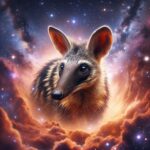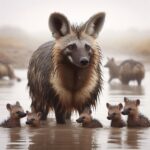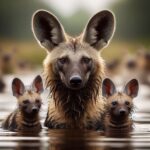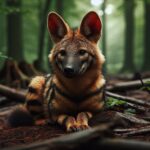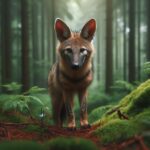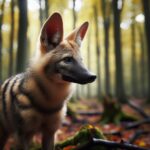The aardwolf (Proteles cristata) is another fascinating animal native to Africa and is often confused with the aardvark due to its similar name, but they are quite different. Here’s a detailed breakdown of the aardwolf:
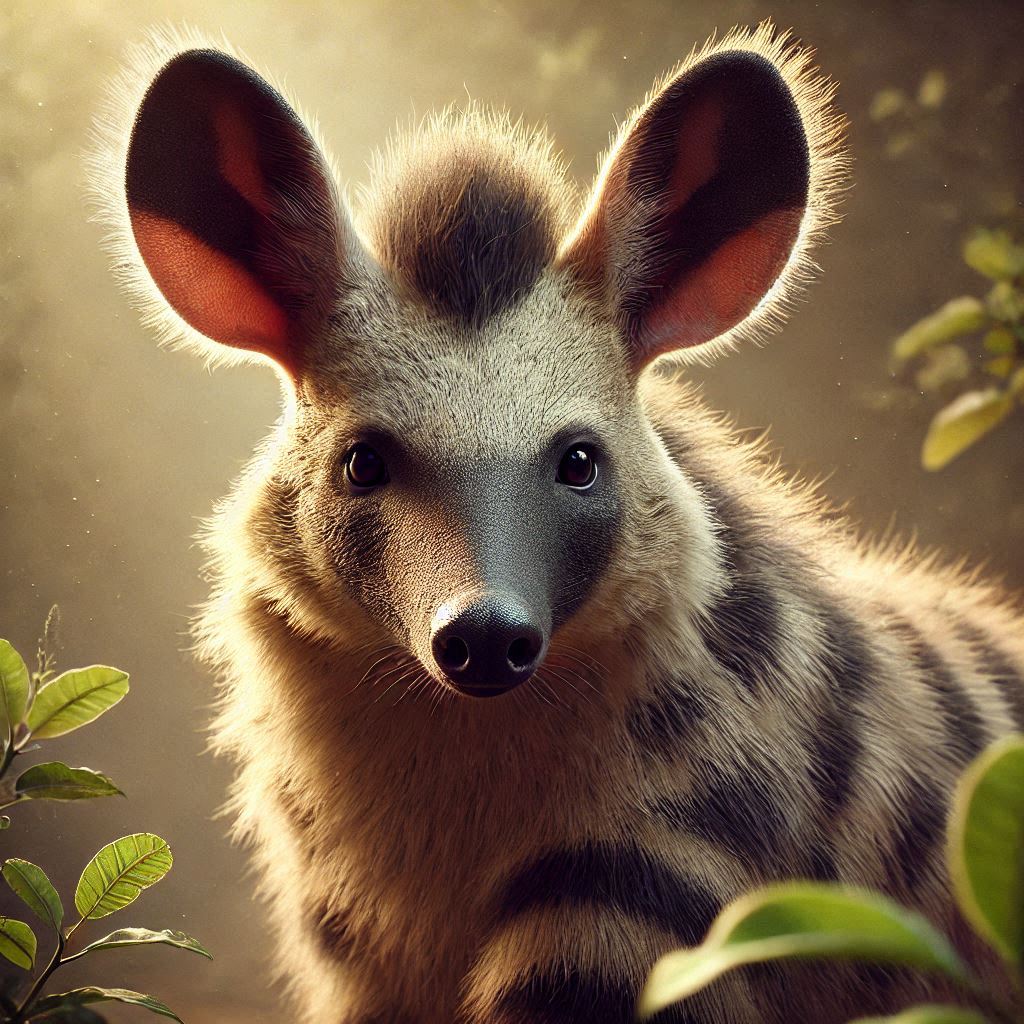
Aardwolf: Detailed Overview
Classification:
- Kingdom: Animalia (Animals)
- Phylum: Chordata (Animals with a spinal cord)
- Class: Mammalia (Mammals)
- Order: Carnivora (Carnivores)
- Family: Hyaenidae (Hyena family)
- Genus: Proteles
- Species: Proteles cristata
The aardwolf is the only living member of the genus Proteles and belongs to the hyena family (Hyaenidae), though it is smaller and has a different diet compared to its larger relatives like the spotted hyena.

Physical Characteristics:
- Size:
- Length: Around 45 to 60 cm (18 to 24 inches) from head to body, with an additional tail length of 25 to 30 cm (10 to 12 inches).
- Weight: Generally between 8 to 14 kilograms (18 to 31 pounds), with males being slightly larger than females.
- Body Structure:
- Coat: The aardwolf has a shaggy coat of pale yellowish to brown fur, with darker vertical stripes running down its back and sides. This coat helps camouflage it in the wild.
- Head: It has a pointed face with a relatively small snout compared to its hyena relatives.
- Ears: Large, upright ears which are very sensitive to sounds.
- Claws and Teeth: Unlike other hyenas, aardwolves have smaller, weaker jaws and small teeth because they are insectivorous (feed on insects rather than larger prey). Their claws are also adapted for digging.
- Tail: It has a long, bushy tail, which is used for balance and communication.
Habitat:
- Range:
Aardwolves are found in southern and eastern Africa, including parts of South Africa, Namibia, Botswana, Zimbabwe, and Mozambique. - Preferred Habitat:
They prefer savannas, grasslands, and open woodlands where they can easily find their insect prey and dig burrows. - Burrowers:
Aardwolves often take shelter in abandoned burrows of other animals, such as aardvarks or porcupines. They can also dig their own burrows if necessary.
Diet:
- Primary Diet:
Aardwolves are insectivores, feeding almost exclusively on termites and other insects. They do not hunt larger animals like other hyenas. - Feeding Behavior:
- Aardwolves use their keen sense of smell to locate termite mounds, and their sharp claws help them dig up the mounds.
- They have long, sticky tongues that allow them to lap up termites and other insects from the mounds.
- They consume up to 200,000 termites in a single night, depending on availability.
- Diet Preferences:
- Termites make up about 80% of their diet, but they also eat ants and beetles.
- They are particularly active in the early evening and night when their insect prey is most active.
Behavior:
- Nocturnal:
Aardwolves are primarily nocturnal (active at night), coming out to forage for food after sunset. - Solitary and Territorial:
- Aardwolves are solitary, but they can sometimes be seen in pairs, usually during the mating season.
- They are territorial animals and mark their territories with scent markings from their anal glands.
- They also use their loud, harsh calls to communicate with other aardwolves, especially to signal danger or define territory.
- Movement:
Aardwolves have a unique, shuffling gait when walking. They are not very fast runners but are good diggers and climbers. - Social Behavior:
While they are generally solitary, mothers will stay with their offspring for a period before the young ones venture off to establish their own territories.
Reproduction:
- Mating Season:
The aardwolf’s mating season typically occurs during the rainy season when food is abundant. - Gestation:
Aardwolves have a gestation period of about 90 to 100 days. - Offspring:
- A female aardwolf typically gives birth to 2 to 4 pups per litter.
- The pups are born blind and helpless, but their eyes open after about 10 days. They are weaned by about 6 weeks old, although they remain with the mother for several months.
- The mother will often protect the pups in an abandoned burrow or within a den she digs herself.
Conservation Status:
- IUCN Red List: Least Concern
Aardwolves are classified as Least Concern by the International Union for Conservation of Nature (IUCN). Their population is stable in the wild, and they are not facing significant threats at the moment. - Threats:
- The primary threats to aardwolves include habitat loss due to human activities like agriculture and poaching for their fur in some areas.
- They are sometimes killed by farmers who see them as a threat to livestock, though this is rare.
- Role in Ecosystem:
Aardwolves play a crucial role in controlling termite populations, which helps maintain the balance of their ecosystems. Their burrowing activities also benefit other species.
Fun Facts:
- Not a True Hyena: Despite being part of the hyena family, aardwolves are more closely related to the mongoose than the larger hyenas like the spotted hyena.
- Termite Specialists: Aardwolves have specialized teeth and jaws suited for their termite-based diet. Unlike other hyenas, they do not have the strong jaws necessary for cracking bones and hunting large prey.
- Territorial Calls: Aardwolves can produce a variety of vocalizations, including a distinctive, harsh, and grating call used to mark their territory or signal distress.
- Shuffling Walk: Aardwolves have a distinctive shuffling walk, which helps them conserve energy while they move slowly at night.
- Nighttime Foragers: They are highly adapted to night hunting, with large, sensitive ears and a keen sense of smell to locate insects even in the dark.
- Shorter Lifespan: In the wild, aardwolves can live up to 10 years, although in captivity, they may live a bit longer due to the absence of predators and consistent food supply.
- Insect Consumption: An aardwolf’s diet of termites and other insects is a unique adaptation among carnivores, especially in the hyena family, where most members are scavengers or predators.
Would you like more details about aardwolves or comparisons with other members of the hyena family? Let me know! 😊
